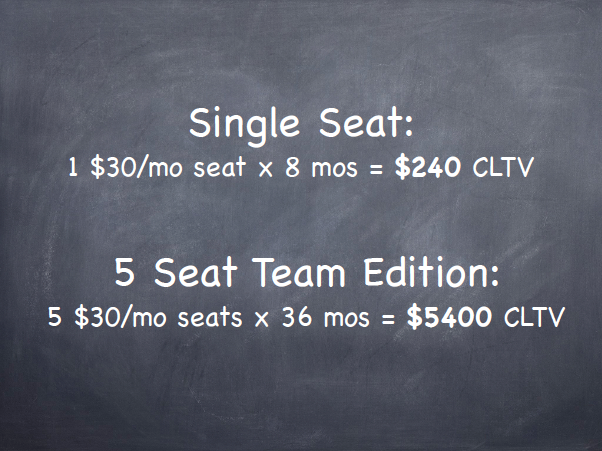Recently I’ve been fortunate enough to meet with a number of outstanding entrepreneurs building self-service SaaS business at the bottom of the market. A customer base made up of Very Small Businesses and individual business purchasers in slightly larger companies. By all means, if you can build a $100m self-service SaaS business without the need for a sales team, a client success team, webinars, getting on planes, and all that — go for it. One con is that these businesses often are tougher to gain a longer-term competitive advantage in unless there is a network effect (e.g., DropBox). And competition thus ends up being even fiercer. But from a business model perspective, why invest in sales, demand gen, and all that if you don’t have to? Why not just build a wonderful product and let them all sign up on their own?
Let me just share one semi-obvious piece of math and learning. No matter how hard I tried at EchoSign to drive up self-service as a % of our revenue, the laws of this math and gravity held it back to a minority of our revenue. Just as it is at Box and Yammer and many others as well that started as simple self-service models.
Here’s the thing. If your product is 100% individual-focused, and you add just enough features to sell to a Team, to tilt just slightly upmarket — you can grow your revenue, at least a segment of your revenue, by 20-30x.
 Why? The key is a combination of (x) churn and (y) value. Virtually every self-service, individual seat web service churns at a relatively high rate — from maybe 2.5% a month at best, to 3.5% or 4.0% a month or more in many cases. (There are exceptions.) So that means maybe your customer lasts 8-10 months, maybe a bit longer but not too much.
Why? The key is a combination of (x) churn and (y) value. Virtually every self-service, individual seat web service churns at a relatively high rate — from maybe 2.5% a month at best, to 3.5% or 4.0% a month or more in many cases. (There are exceptions.) So that means maybe your customer lasts 8-10 months, maybe a bit longer but not too much.
Now, come up with a slight extension of that same product, wherein some group, team, or segment of an entire enterprise can use it together. Let’s call it just 5 seats to start, instead of 1. Maybe you add management-level analytics. Some sort of collaboration. I’m not sure what it will be for you. But let’s call it the most basic features necessary so a team or a group will buy, instead of an individual user.
And what you’ll find is epic on the churn side. Your churn as the deal gets just a smidge bigger will fall dramatically, toward 1-1.5%. And as you add more seats, the churn will trend toward 0% and eventually become negative. Because your customers will add more seats over time than they cancel.
Now, since SaaS compounds, and is a long-term play, over 3+ years, you’ll be just so far ahead. Because that single-seat user that left after 8 months may be gone forever. But that 5-seat Team edition sale customer … is still there in Year 2 and Year 3, paying you. And maybe even adding seats.
All of a sudden, in say a $30/month product … you’ve gone from a $240 Customer Lifetime Value for the single seat purchase to $5400 CLTV over 3 years from the same customer, from the same basic core product, just with whatever additional functionality you need for your Team or “Enterprise” edition. And the math just gets better as you support slightly larger teams. That’s truly epic.
So what’s my point? I’m not saying that if you are building a freemium or self-service product you should immediately Go Enterprise. Although I’ve done that, that exact path.
What I am suggesting at least thinking about is adding a layer. If the one-seat freemium thing is working for you, add a Team edition, or a so-called “Enterprise” Edition. Even if it’s just for an Enterprise of Five. And hire a sales rep or better yet two to actually talk to these customers and try to close them — go beyond just customer support.
Because if it works, just that little extra functionality for that extra edition — you can dramatically increase your growth rate. Because all of a sudden, that same customer, that same lead, that same person who came by your website or app … all of a sudden is worth 20-30x more. Same effort to get them to your site or app. But 20-30x the return.
(note: an updated SaaStr Classic post)


